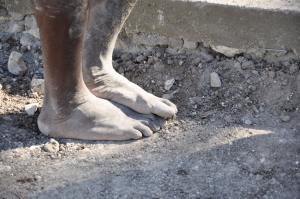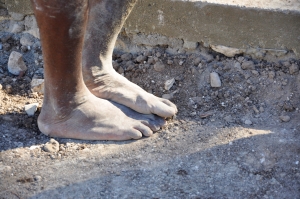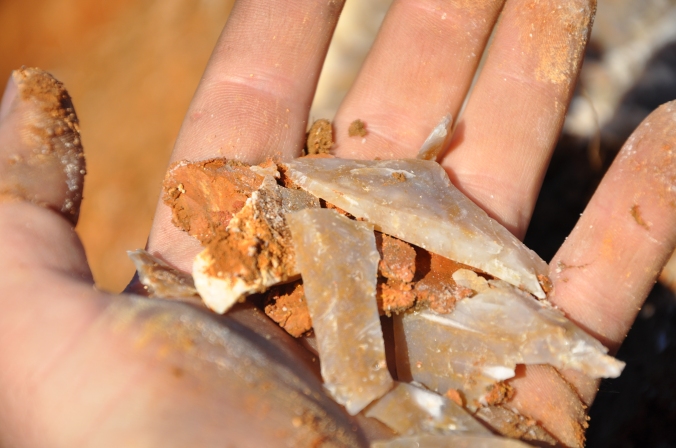farming
Feed My Sheep Farm
This was a common sight in Haiti:

This boy broke my heart. He walked about like an old man–slow and methodical. He used his distended belly as a prop.

Mud cookies are eaten to fill their bellies when there is no food in the house. Pregnant women also eat these to get the minerals that are missing from their diet.
Hunger is a fact of life in Haiti.
In fact, according to World Vision’s website, 2.4 million Haitians cannot afford the recommended minimum daily calories.
One look into those twins faces on Christmas Eve and Jared and I knew we had to do something.
So, we put our ag nerd brains together, emailed a few of our former advisors from college and various jobs and started the development of what has come to be known as the “Feed My Sheep” farm. Our group’s goal is to develop a livestock operation near Ecole Bon Berger school in Grand Gode, Haiti that will provide the school with eggs, milk and meat products, as well as develop a sustainable 3 acre farm outside of L’Artibontie. Our goal in this is to teach the Haitian people agriculture skills that they can use to manage this farm. We want this farm to be completely Haitian run and independently operational in a year.
This is a big undertaking and we need your help. We need people with agriculture expertise to share their knowledge as well as monetary donations to purchase the supplies in country. We also need your prayers as we seek to implement this plan quickly, before anyone else in the community gets more ill or passes away from starvation.
Check out our plan here.
To donate money via PayPal to purchase livestock or equipment click here.
Thanks! God is doing great things! 🙂

35 For I was hungry and you gave me something to eat, I was thirsty and you gave me something to drink, I was a stranger and you invited me in, 36 I needed clothes and you clothed me, I was sick and you looked after me, I was in prison and you came to visit me.’
37 “Then the righteous will answer him, ‘Lord, when did we see you hungry and feed you, or thirsty and give you something to drink? 38 When did we see you a stranger and invite you in, or needing clothes and clothe you? 39 When did we see you sick or in prison and go to visit you?’
40 “The King will reply, ‘Truly I tell you, whatever you did for one of the least of these brothers and sisters of mine, you did for me.’ –Matthew 25:35-40
Is Vocational Education Possible in Haiti?
I became an agriculture teacher after finishing college, getting married and moving back to the region that I grew up in. Becoming an ag teacher had never been on my radar throughout college but seemed to be the best way to use my skill set once I moved back to our rural corner of the world. I am and have always been PASSIONATE about vocational education. We need a world that works. I see kids everyday that could benefit from developing a skill in school that can provide them with income after graduation. I see kids willing to work and learn that are waiting anxiously for someone to teach them.
…and I saw the very same thing in Haiti and it
broke.
my.
heart.
The Haitian people are the most hardworking and loving people I have ever met. They are also some of the poorest people I have ever met. Eighty percent of the population lives in poverty and more than 40% are unemployed.
Let me stress this point, the people of Haiti desperately WANT TO WORK however without a viable skill set there is not much opportunity in this underdeveloped nation.
So the ag teacher in me wants to know—how can we fix this?
We have willing students and they have opportunities to use their potential skills to make their lives better but they have no teacher. How are we going to fix this?
We need people like you and me that are willing to share our knowledge of mechanics, welding, carpentry, agriculture, EVEN JEWELRY MAKING with the people of Haiti. We need people willing to give of their time to develop a skill set in those that are DESPERATELY HUNGRY not only for food but for knowledge.
I am a firm believer that education is the answer to poverty. We have willing students. Who will be the willing teachers?
I am asking for guidance–I know I have movers and shakers that read this blog and I know I have people who are just as passionate about vocational education as I am out there reading along. How can we get vocational leaders, colleges and workers involved in the development of skill sets for the Haitian people? Some of these skills, like stick welding, can be taught in a few short months. How can we get organizations involved in “teaching these people to fish” rather than doing the “American thing” and giving them a handout. How can we motivate others to give them a “hand-up” instead?
Now it’s your turn, I want to hear from you in the comment section! 🙂 If you are willing to help or if you know of an organization, school or company that may be willing to help train Haitians in vocational skills please let me know! I would love to see mechanic, agriculture or welding students doing a semester of teaching in Haiti just like other majors do overseas.
Stepping off the soap box and putting on my work gloves,
Jillian

Girls in the mountain village above Arcahaie, Haiti that came in from the bean field to see what was happening at the church.
GPS: Where are we going?
Uncle Gene recently invested into a small guidance system for the farm. So far, the guys have really enjoyed fiddling around with it and learning how it works.
I posted a picture on my Facebook today of Jared setting it up to spread oats with the tag-a-long. One of the comments I received made me giggle, “Do you get lost in the field?”
It’s a great question! The answer is yes, occasionally we do! However, it’s not the “Holy cow, how do I get home?” kind of lost but the “Haven’t I planted this already?” kind of bewilderment.
Oat seed are very small. We don’t plant or drill them into the ground when we are planting a cover crop. Instead we scatter them using a wagon called a tag-a-long that has plates on the back that fling the seed over a a wide area behind the wagon as we pull it. It’s a similar concept to those small, homeowner fertilizer spreaders. After the oats have been spread, we disc them in. The disc disturbs the ground just enough to chop weeds and cover the seed.
The GPS is handy because, from the tractor seat, the driver can’t see if he or she is running over ground that already has oats spread on it. The GPS marks on the screen in one color where the oats are already on the ground, in another color where oats need to be spread and another where we have overlapped. It also, has a row of lights that help keep the driver aware of the right path (the sweet spot where the tractor is perfectly centered.) This helps prevent overlap and saves seed and money.
The GPS is not only useful for spreading small grain, but for spraying chemicals. It helps prevent us from spraying too many chemicals by helping us identify areas that have already had chemicals applied. This is beneficial not only financially but environmentally. It enables us to use just the chemicals we need, which means the excess doesn’t end up washing away into nearby creeks.
So far, we are loving the GPS (which we named Minkus by the way because he’s so smart!) Do any of you have experience with GPS and agriculture? Do y’all have tips for a couple of newbies?
Closing Out Cotton Season
I am so thankful that cotton season is coming to a close. As I write this, Jared is hurrying to harvest the last 30 acres or so before the rain moves in. Since, I have been an absent blogger, here is a picture or two from today.
Pardon the scrappy looking cotton, I never seem to have my camera with me on good days. This was the first field planted (and replanted) and the last harvested. The elements are definitely taking a toll on yields in this field.
Overall, it has been a good cotton season. Despite several breakdown, Jared and the boys have had good yields and several surprises from new cotton varieties. Here’s hoping we finish up and don’t have a (cottony) white Christmas!
Plowing Up Peanuts and Grading Papers

We are plowing up peanuts on this lovely fall day! We have had a good harvest so far, with the exception of a few breakdowns and rain interruptions.

This year we have had the chance to lease a Challenger to plow up peanuts and pick with. Boy has it been nice! I’ve actually been able to ride comfortably on the buddy seat instead of a arm rest! (Buddy seats also make it easier to grade history tests while spending quality tractor time with the hubby)
The Challenger has allowed us to gather more efficiently because it can haul the bigger equipment better than some of the other tractors. We were a little anxious about using it at first, having no experience with the brand, but we have found that it is just like a Massey Ferguson. That makes my red-tractor-loving husband very happy!

I’m sorry for the long time between posts! It has been a busy time on the farm and it doesn’t look like it will slow down anytime soon. We start cotton harvest as soon as we finish with peanuts. Hopefully, we will have yall a cotton post up in the future!
From the buddy seat of a tractor,
–Jillian
No Bugs for Dinner Please!
Today, I read an AWESOME article by Holly Spangler over at Prairie Farmer. It had several anecdotal stories about the disconnect between HOW our food is produced and HOW we expect it to look and taste.
After reading it I though about this picture:
Yes, I squealed too.
Jared and I were busy shucking sweet corn and field corn (I’m not a fan of the sweet kind. Yes, my Midwestern friends have told me this is weird.) when I came across this little corn ear worm.
I didn’t throw the ear away just because it had a little worm on it. I watched him munch on a kernel for a little while then calmly cut the offensive end of the ear off, leaving it on the ground the for little guy to munch on another day. Thinking back on that after reading the article I realized that I wouldn’t have responded that way if I had of purchased the corn from the grocery store instead of getting it from a kindly neighbor. I would have probably still squealed, but would have been more selective about which grocery store I bought corn at next time.
There is a disconnect between what consumers (even those like me in ag) want and how they have to get it, especially if they are interested in certified organic. By design, food raised organically is going to have more insect pressure. It’s the cost you pay for more “natural” food. And even in the conventional sector there are still bugs. (Trust me, I had an enormous grasshopper jump on me in the cotton field today!) So how do we bridge the gap?
Well, I don’t have the answer but over the past semester teaching elementary age students, I have tried to answer their questions and get them thinking about agriculture. Bug stung peas, corn ear worms and critters munching on things in my grandma’s garden were just part of my life as a child. We worked and washed around them. I have tried (and will still be trying) to help my students understand the ecological balance that exists between humans, insects and the plants we both love to eat. It may not make a huge impact on how people in the U.S. view agriculture and food, but at least it’s a step in the right direction.
What about you? How are you working in your community to bridge the gap between those several generations removed from the farm and the agriculture industry?
By the way, if you want another awesome blog post on corn and awesome technology check out Wag’n Tales’s post!
Getting that Purple Seed in the Ground!
I swore that when I got a new camera I would begin blogging like it was no one’s business… Oh well, here’s to good intentions!
It’s planting time! Jared and the boys have been in the field late every night trying to prepare new ground, fix terraces and actually get this wonderful purple cotton seed in the soil.
On farms where we aren’t using conservation tillage practices and were unable to plant cover early enough due to lease arrangements, the boys and I have rebuilt terraces by pulling misplaced soil back up to its “proper” spot. From there, the boys have disked, plowed and bedded in preparation for planting.
Following the contour of the snaky terraces provides some not-so-straight planted rows. Nevertheless, the cotton is in the ground. Now all we need is a good rain.
Hopefully, it won’t keep us waiting like it did last year. Replants are no fun!
Goliath the Rock and our Coastal Plain Soils
Uncle Gene and Jared are taking in new ground. One field, had a good size rock (now nicknamed Goliath) that they decided to dig up to make plowing easier.
But they couldn’t find the bottom of the rock.
Jared had my camera and took a few pictures…
…and maybe a tough man glamour shot of Gene on the backhoe.
The rock proved to be too big to remove for a reasonable price. It would also be difficult to find enough soil to put back in the hole in place of the rock, so the boys have decided to leave it and work around it.
Rocks like this are common in coastal plain soils. So are fossil fragments like this.
According to soil scientists and agronomists, coastal plains soils consist of consolidated marine sediment which was formed when the ocean covered Florida and most of Alabama up to the Piedmont near Lee County.
To find out nifty information about soils in your state, get to know the folks at NRCS.





























